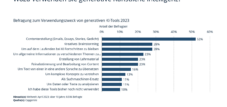Artificial Intelligence: Is generative AI a content AI or exclusively an AI language model, and what other AI models are there?
Language selection 📢
Published on: September 20, 2024 / update from: September 20, 2024 - Author: Konrad Wolfenstein
Artificial Intelligence 🤖: More than just language models – The world of generative AI 🌐 and its diversity
🚀👤 Artificial intelligence (AI) is on everyone’s lips these days. Generative AI in particular has become increasingly important in recent years and is revolutionizing numerous industries. But what is generative AI really? Is it just an AI language model specialized in text creation, or can it do more? To answer these questions, it is important to look not only at generative AI in particular, but also at the different types of AI models, their applications and their potential.
✨ What is generative AI?
Generative AI basically describes any form of AI that creates new content, be it text, images, music or even videos. It differs from other AI models in that it doesn't just analyze or classify, but actually creates something new. The current focus is particularly on so-called language models, such as GPT models (Generative Pre-trained Transformers), which are able to generate human-like texts. These models have become enormously popular in recent years due to their amazing abilities to create complex and coherent text.
But generative AI can do much more than just create texts. It is also used in other creative areas, such as creating artwork, composing music, or developing new designs. Generative AI is used in medicine to generate new molecules for drugs and in the film industry to produce animated characters or edit footage. The versatility of generative AI is astonishing and opens up numerous possibilities in a wide range of industries.
🗣️ Language models and their role within generative AI
When you talk about generative AI, many people immediately think of language models. Models like GPT-4 and its predecessors have had a major impact on the way we interact with AI today. These models are trained to recognize patterns from large amounts of text data and to create new texts based on these patterns. The quality of these texts has continued to increase in recent years, so that they can now hardly be distinguished from human texts.
But what makes a language model like GPT-4 so powerful? It is the underlying neural networks that are trained using so-called “deep learning” methods. These networks simulate the human brain using millions, if not billions, of parameters to understand language and form new sentences. The results are impressive: GPT-4 can answer complex questions, write creative texts, create technical documentation and even program.
However, language models are only one facet of generative AI. Although they occupy a central place due to their wide range of applications and the continuous improvement of their capabilities, there are many other models and approaches in the world of AI.
🌟 More artificial intelligence models
In addition to language models, there are numerous other types of AI models that specialize in different tasks. A central difference is between discriminative and generative models. Discriminative models are primarily used to classify data or make predictions. Examples of this are image classification models or speech recognition systems. These models are designed to make a specific decision or prediction from given data.
Generative models, on the other hand, aim to create new data that is similar to the training data. This can be done in many ways. An example of this are the so-called Generative Adversarial Networks (GANs). GANs consist of two neural networks that compete with each other: a generator that tries to create new data and a discriminator that tries to distinguish this new data from real data. Through this competition, both networks continually learn, so that the generator produces more and more realistic data over time. GANs are often used to create images that appear so realistic that they can hardly be distinguished from real photographs.
Another important model in generative AI is Variational Autoencoders (VAEs). These models learn to compress (encode) data into a lower dimension and then reconstruct (decode) it again. In the process, some of the information is “lost,” making it possible to create new variations of the original data. VAEs are commonly used in image and music generation.
🚀 Applications of generative AI: From content to innovation
The use of generative AI is by no means limited to creating texts. Rather, it has the potential to transform numerous industries. Here are some examples:
1. Media and journalism
Generative AI is increasingly being used to create content. This is not just about simple text generation, but also about creating tailor-made articles that are aimed at specific target groups. The automated writing of news reports or blog posts is also one of the options.
2. Creative industry
Artists and designers use generative AI to develop new ideas or support their creative processes. From creating new fashion designs to musical compositions, AI is opening up completely new horizons for creatives. In the film and gaming industry, AI models are used to animate and create 3D characters or scenes.
3. Medicine
In medical research, generative AI has the potential to revolutionize drug development. AI can be used to generate new molecules or proteins that could be used to treat certain diseases. This significantly accelerates the development process of new drugs.
4. Architecture and Design
Architects use AI to develop new building or city designs. The ability to create numerous variations of a design allows planners to work faster and more efficiently. At the same time, AI models can incorporate ecological and economic aspects into their designs, leading to sustainable solutions.
5. Marketing and eCommerce
Companies use generative AI to create personalized content for their customers. From tailored ads to product recommendations, AI can help improve customer experiences and increase conversion rates.
⚖️ Challenges and ethical questions
Despite the numerous applications and enormous potential of generative AI, there are also some challenges that need to be considered. One of the biggest problems is the issue of copyright. If an AI is capable of creating works of art, music, or lyrics, who owns these works? The person who developed the AI model or the user who uses the AI?
Another challenge is responsibility*. What happens if generative AI creates false or misleading information? This could have serious consequences, particularly in areas such as journalism or science. It is important to develop clear guidelines and ethical standards to prevent the misuse of generative AI.
🌍 The future of generative AI
The development of generative AI is still in its early stages. Although impressive progress has already been made, much more will be possible in the coming years. In particular, the combination of generative models with other AI technologies, such as machine learning or robotics, could lead to completely new possible applications. One can imagine a future in which AI not only creates content but also makes decisions independently, develops new technologies or even solves social and economic problems.
Generative AI is therefore much more than just a language model for text creation. It covers a wide range of technologies that can be applied in many industries. Despite the existing challenges, the opportunities and possibilities that this technology offers outweigh the challenges. In a world that is increasingly digital and connected, the role of generative AI will continue to grow – potentially fundamentally changing the way we work, learn and create.
📣 Similar topics
- 📚 The evolution of artificial intelligence and its models
- 🖊️ The role of generative AI in today's world
- 🖼️ Creative networks: art and design through AI
- 🎵 Music and generative AI: Compositions of the future
- 🧪 New horizons in medicine through generative AI
- 🏗️ Architecture and Design: Innovation through Generative AI
- 📰 Generative AI in journalism: opportunities and challenges
- 💼 Marketing and e-commerce: Personalized content through AI
- 🤖 The combination of generative models with other technologies
- 🏛️ Legal and ethical issues of generative AI
#️⃣ Hashtags: #ArtificialIntelligence #GenerativeAI #AIModels #LanguageModels #ApplicationsAI
📌 Other suitable topics
🖥️🌟 Artificial Intelligence (AI): Advances and Applications
🎨 Generative AI: Technologies and Applications
Generative AI encompasses a wide range of technologies and applications. Essentially, the AI systems are able to generate new content from existing data and patterns that is similar to the training data, but not identical. A well-known example is the large language models such as GPT-4 from OpenAI, which can produce human-like texts.
🎭 Diversity of generative AI models
However, it would be too short-sighted to view generative AI only as language models. In fact, there are a variety of generative AI models for different areas of application:
📝 Text generation
In addition to the language models mentioned, there are AI systems that can write poems, stories or even scientific articles.
🎨 Image generation
Models like DALL-E 2 or Midjourney can create photorealistic images based on text descriptions.
🎼 Music composition
There are AI systems capable of composing original pieces of music in various genres.
📹 Video generation
Advanced models can even generate short video sequences based on text descriptions.
💻 Code generation
AI assistants like GitHub Copilot can generate program code based on natural language descriptions.
These examples show that generative AI is far more than just a voice model. Rather, it is a versatile technology for creating various types of content. It is therefore quite appropriate to speak of a “content KI”.
🤖 AI versatile: Other models and approaches
At the same time, it is important to understand that generative AI is only a subset of artificial intelligence. There are a variety of other AI models and approaches that have been developed for different tasks and applications:
📊 Classification models
These AI systems assign input data to specific categories. An example would be the automatic detection of spam emails.
📈 Regression models
They are used to predict numerical values, for example for price forecasting or predicting sales figures.
💽 Clustering models
These unsupervised learning methods group similar data points without knowing predetermined categories. They are used, for example, in customer segmentation.
🎯 Recommendation systems
AI models that generate personalized recommendations, for example for products or content.
🚨 Anomaly detection
Models that identify unusual patterns in data, for example for detecting fraud in the financial sector.
🎮 Reinforcement learning
AI agents that learn to develop optimal action strategies by interacting with an environment. This is used, among other things, in robotics.
📷 Computer vision
AI systems for analyzing and interpreting images and videos, for example for facial recognition or autonomous driving.
💬 Natural Language Processing
Models for processing and analyzing natural language, which are used, for example, for translations or sentiment analysis.
This variety of AI models makes it clear that artificial intelligence encompasses a wide range of technologies and applications. Generative AI is a particularly fascinating and rapidly growing area that offers great potential for creative and productive applications.
🧠 Understand AI architectures
An important aspect of considering AI models is your architecture and functionality. Many modern AI systems are based on artificial neuronal networks that, in a way, imitate the functioning of the human brain. These networks consist of interconnected “neurons” that process and pass on information. By training with large amounts of data, these networks learn to recognize patterns and carry out tasks.
A particularly powerful form of neuronal networks are the so-called “deep learning” models. These have many layers of neurons, which enables them to grasp very complex relationships. Many of the most impressive AI breakthroughs in recent years, including the advanced generative models, are based on deep learning.
📚 Transformer models
Another important trend in AI research is the so-called “transformers” models. This architecture, which was originally developed for tasks in language processing, has proven to be extremely versatile and efficient. Many of the leading generative AI models, such as GPT-3 or Bert, are based on the transformer architecture.
⚙️ Combination of techniques
It is also important to emphasize that the boundaries between different AI models and approaches are often blurred. Many modern AI systems combine different techniques and architectures to handle complex tasks. For example, an AI system for image analysis could combine elements from computer vision, deep learning and generative models.
🌐 Ethical and social issues
The rapid development in the field of AI also raises important ethical and social questions. The use of AI systems, particularly generative models, has far-reaching implications for areas such as work, creativity, privacy and information dissemination. It is therefore extremely important that the development and use of AI technologies are accompanied by a broad social discussion and an appropriate regulatory framework.
🛡️ Challenges and discussion points
Some of the key challenges and discussion points related to AI models are:
🔒 Data protection and privacy
AI systems often require large amounts of data for training, which raises questions about protecting personal information.
⚖️ Bias and fairness
AI models can inherit unintentional biases from their training data, which can lead to unfair or discriminatory results.
🔍 Transparency and explainability
Many advanced AI models work as a “black box”, which makes it difficult to understand their decision-making processes.
📜 Copyright and Intellectual Property
The ability of generative AI models to generate new content raises complex legal questions.
🏢 Impact on the labor market
Increasing automation through AI could lead to shifts in the world of work.
🚨 Security and Abuse
AI technologies could be misused for harmful purposes such as creating deepfakes or spreading disinformation.
🎯 Opportunities and potential
Despite these challenges, the development of AI models offers enormous opportunities and potential. In many areas, AI systems can complement and augment human capabilities, which can lead to increases in productivity, new insights and innovative solutions to complex problems.
✨Subarea of artificial intelligence
Generative AI is a fascinating and promising sub -area of artificial intelligence that goes far beyond pure voice models. As a “content KI”, it has the potential to support creative processes and to enable new forms of content. At the same time, it is important to consider generative AI in the broader context of the diverse AI landscape, which includes a variety of models and approaches for a wide variety of applications. The further development and the responsible use of these technologies will undoubtedly have a major impact on our future society and economy.
📣 Similar topics
- 🤖 Advances in artificial intelligence
- 🌐 The world of generative AI
- 🖼️ Creative image generation with AI
- 🎵 Music composition through artificial intelligence
- 📚 Generative AI and the future of texts
- 🎥 Video production through advanced AI models
- 📝 Code generation with AI assistance
- 👁️🗨️ Applications of computer vision
- 💬 Language processing and its applications
- 🛡️ Ethical challenges of AI
#️⃣ Hashtags: #ArtificialIntelligence #GenerativeAI #DeepLearning #ComputerVision #EthicsofAI
We are there for you - advice - planning - implementation - project management
☑️ Industry expert, here with his own Xpert.Digital industry hub with over 2,500 specialist articles
I would be happy to serve as your personal advisor.
You can contact me by filling out the contact form below or simply call me on +49 89 89 674 804 (Munich) .
I'm looking forward to our joint project.
Xpert.Digital - Konrad Wolfenstein
Xpert.Digital is a hub for industry with a focus on digitalization, mechanical engineering, logistics/intralogistics and photovoltaics.
With our 360° business development solution, we support well-known companies from new business to after sales.
Market intelligence, smarketing, marketing automation, content development, PR, mail campaigns, personalized social media and lead nurturing are part of our digital tools.
You can find out more at: www.xpert.digital - www.xpert.solar - www.xpert.plus






























